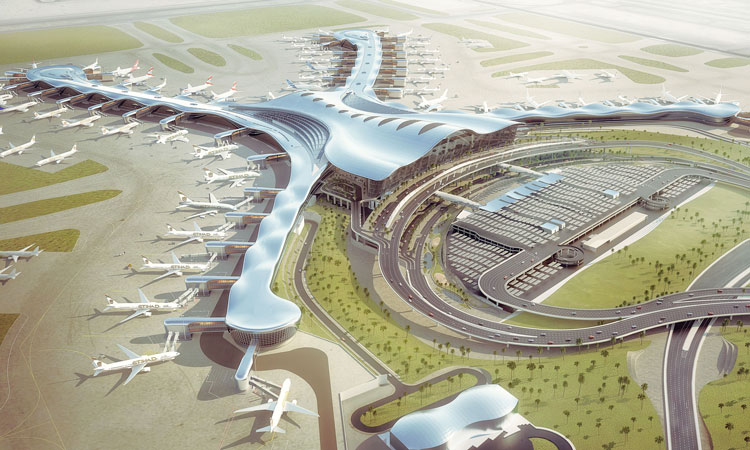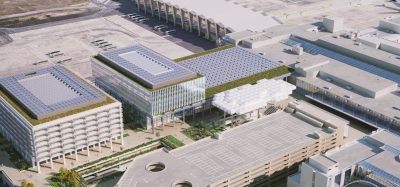Providing the best possible passenger flow levels through AUH
- Like
- Digg
- Del
- Tumblr
- VKontakte
- Buffer
- Love This
- Odnoklassniki
- Meneame
- Blogger
- Amazon
- Yahoo Mail
- Gmail
- AOL
- Newsvine
- HackerNews
- Evernote
- MySpace
- Mail.ru
- Viadeo
- Line
- Comments
- Yummly
- SMS
- Viber
- Telegram
- Subscribe
- Skype
- Facebook Messenger
- Kakao
- LiveJournal
- Yammer
- Edgar
- Fintel
- Mix
- Instapaper
- Copy Link
Posted: 6 December 2015 | Ahmad Al Haddabi | No comments yet
Key to Abu Dhabi Airports’ on-going development is to ensure that travellers who use its airports are given the best possible experience; in having the best services and facilities on offer and providing the best possible ‘flow’ through its airports. Chief Operations Officer, Ahmad Al Haddabi, tells us what passengers can expect when travelling through Abu Dhabi International Airport and the on-going work there to ensure travellers continue to receive high levels of service in the future.


A passenger arrives at Abu Dhabi International Airport (AUH). He is bound for London on the Etihad flight which leaves at 1.30pm. He has already checked-in online and printed his boarding pass. It’s a short visit, so he’s only taking hand luggage and does not need to go to a check-in desk. If he’s a UAE resident he will have been able to sign-up for the e-gate facility, allowing him to move rapidly through immigration and security without his passport being stamped. All departing passengers from AUH will also benefit from the new Traveller Document Authentication System (TDAS), which has recently been installed in Terminals 1 and 3 to automate the process of verifying passenger documents before immigration. This system reduces queues, improves passenger flow and satisfaction, and enhances security.
There are then a whole range of facilities available to him, depending on how he feels like spending his time before boarding his flight. He can have a coffee, a drink or a meal at any of a number of food and beverage outlets. He could go for a massage, or he may want to buy a gift for a friend in London from Duty Free. There may be one of the many promotions going on, so if he has spent more than 200 AED (roughly US$50), he will be able to take part in a raffle to win a car. At no time since he arrived at the airport will he have had to queue.
Meanwhile, another passenger arrives on an Etihad flight from Sydney. He is also travelling to London, but is transiting through Abu Dhabi. Having disembarked from the aircraft, he can enjoy moving around the transit area using the electronic way-finding system that will guide him smoothly to the departure hall in Terminal 3. If he is feeling tired, he can take advantage of the sleeping pods, or he could browse the new art and photography collections on display around the airport, showing images from Abu Dhabi’s past and present to convey its heritage and development.
These are examples of some of the initiatives that have been put in place by Abu Dhabi Airports to improve passenger experience. Given the increasing number of travellers using AUH, diversifying and increasing the number of facilities available for their use and entertainment cannot happen quickly enough. In 2014, Abu Dhabi Airports reported a 20 per cent increase in the number of passengers, with 20 million passing through AUH during that year for the first time in the airport’s history. July 2015 saw another record broken as 2 million passengers used the airport in a single month, again unprecedented. And records were broken again the following month, when 2.5 million passengers travelled through in August 2015, the highest figure ever. In less than 10 years, annual passenger numbers have more than trebled and the trend is inexorably upwards. By 2020, it is expected that more than 45 million people will be using AUH each year.
How will Abu Dhabi Airports manage this growth and enable passengers to enjoy the experience of arriving into and departing from AUH in the future? The aforementioned examples are what customers see and what they experience, to make their time at the airport as pleasurable as possible. This however, is only one part of what needs to be done to manage passenger flow. The other side of the equation is the expansion of the airport’s physical infrastructure and since 2009, a considered programme of investment has been on-going for this very purpose. The biggest single piece of infrastructure being developed at AUH is the Midfield Terminal Building (MTB) – a brand new terminal which will transform the airport’s ability to handle the expected increase in passenger numbers.
So-called because of its location mid-way between the northern and southern runways at Abu Dhabi International Airport, the MTB is one of the most impressive infrastructure projects ever undertaken in the aviation industry. It is 700,000m2 and will add 30 million passengers per year to the airport’s capacity, as an IATA level of service A, when it opens in 2017. Those passengers will be able to enjoy facilities at the cutting-edge of aviation industry technology. One example is the tote based baggage handling system, capable of moving more than 19,000 bags per hour along 27km of conveyor belts.
There will be 30,000m2 of lounge space and 28,000m2 of Duty Free shopping, in which most of the world’s best known brands are expected to have a presence, offering passengers a fantastic shopping experience. The terminal will have 65 contact stands and 14 remote stands, spread around the four separate piers of the building, and a magnificent central processor area. This huge atrium is covered by a distinctive curved roof which gives the impression that it is floating on 18 steel arches. It’s hoped such unique architecture will make the MTB one of the best known structures in the world, on a par with the Sydney Opera House or the Eiffel Tower.
There are currently 20,000 workers on site who are making tremendous progress in bringing the project to fruition. The amount of material being used to build the structure is phenomenal. The largest arch at the front of the main central processor area is 180m-long, 52m-high and weighs 1,000 metric tonnes, making it the world’s longest indoor arch. Approximately 26,000 metric tonnes of steel have been used to construct the piers and gatehouses, and the roof comprises 260,000m2 of aluminium, with 200,000m2 of glass opaque cladding enveloping the building. By the end of 2015 the terminal is expected to be 70% complete. When the MTB opens, it will give passengers an unrivalled experience and make their movement through AUH thoroughly enjoyable and memorable.
Ahead of the opening of the MTB, Abu Dhabi Airports has also been expanding and enhancing the existing infrastructure at AUH, to manage the increasing number of passengers that come and go. 2013 saw the opening of the new arrivals hall, providing a simple and more convenient exit point for arriving passengers. In 2014, the highly prestigious, luxurious VIP terminal was opened. This is a 924m2 facility with its own dedicated drop-off zone, immigration, police and baggage handling facilities. This followed the launch of the newly renovated Al Reem lounge in Terminal 1; 1,500m2 of comfort and convenience providing business class passengers with a ‘home away from home’.
December 2014 saw the re-opening of the upgraded southern runway, which is a very significant step in allowing even the largest of commercial aircraft, such as the Airbus A380, to use AUH, and in doing so considerably increasing the capacity of the airport. The Southern Airfield Renovation Programme also included the construction of an airside road tunnel running underneath the southern runway, which will allow full connectivity between the Midfield Terminal Building and Terminals 1 and 3.
In early-2015, a number of enhancements to the infrastructure at Terminal 1 were unveiled, which have significantly improved the speed, efficiency and enjoyment with which passengers move through the airport, as well as enabling more aircraft to depart on schedule and improving passenger security. Travellers now have more space in which to move about and will spend less time queuing, giving them more of an opportunity to enjoy the multiple retail, F&B and entertainment facilities on offer.
The enhancements include the installation of 350m of new walkways, directly linking the passenger arrival gates to the immigration halls and transfer screening facilities; the opening of nine new code E aircraft stands to accommodate the increasing number of large and wide bodied aircraft at the airport; the introduction of 16 brand new state-of-the-art X-Ray screening machines capable of processing 2,000 passengers per hour; and the removal of the screening process between Terminals 1 and 3, enabling departing and transit passengers to move more freely between the two terminals. In addition, the road access to and from AUH has been significantly improved. Vehicles departing from arrivals, departures and the car parks can now get straight onto roads to central Abu Dhabi, Dubai and local areas such Al Raha, Yas Island and Khalifa City.
Looking ahead, further developments are planned in the near-term, all of which are geared towards delivering additional capacity and services that typify an innovative, dynamic and world-class airport. These will include a new gate dedicated to the Airbus A380, catering for more than 500 passengers, the construction of a new apron, with nine additional long layover parking stands (2 Code F and 7 Code E+) and the expansion of the check-in facilities at Terminal 3.
Abu Dhabi Airports is committed to offering passengers who use its airports the best possible experience. An important part of that experience is being able to move about the airport as easily and as comfortably as possible. Abu Dhabi Airports has always planned ahead to ensure that the forecast growth in the number of passengers can be accommodated without compromising the quality of the airport experience. As the two passengers from Sydney and Abu Dhabi board the Etihad flight to London, they can recline in their seats and reflect that their last two hours in AUH truly was time well spent.
Biography
Ahmad Al Haddabi is Abu Dhabi Airports Chief Operations Officer and is currently responsible for determining the adequacy of measures in the operations of all of the company’s operated airports in respect to compliance, safety, security, environmental performance and cost effectiveness. Ahmad is an aviation engineer veteran with more than 18 years of experience in airworthiness, flight operations, safety management, airline and airport security, airport certification, aircraft accident, incident prevention and investigation. His expertise also extends to air transport bilateral negotiations, technical and administrative management of civil aviation. He has sound knowledge of ICAO methodologies and annexes for regulating international civil aviation and he is familiar with the Chicago convention, and other various international protocols. Over the past 10 years, Ahmad has played a key role in the development of the UAE General Civil Aviation Authority (GCAA). He also contributed to the establishment of ICAO’s Continuing Airworthiness Programmes in the UAE, setting up of the UAE ICAO headquarters in Canada, and the strategic preparation for the ICAO seat election in 2007 which resulted in UAE nomination and election to the ICAO council. He also supervised the compliance of the ICAO Safety Oversight Audit Programmes and the ICAO Security Audit Programmes, which resulted in meeting the ICAO requirements by the UAE. His involvement in the United States Federal Aviation Administration Programmes resulted in awarding the UAE Category One rating in civil aviation. This allowed UAE national carriers to provide services to destinations in the U.S. and code-share with U.S. Carriers. Ahmad has a Master’s degree in Business Studies Management from Southeastern University in the U.S.
Issue
Related topics
Airport development, Airside operations, Passenger experience and seamless travel, Sustainable development, Terminal operations


















